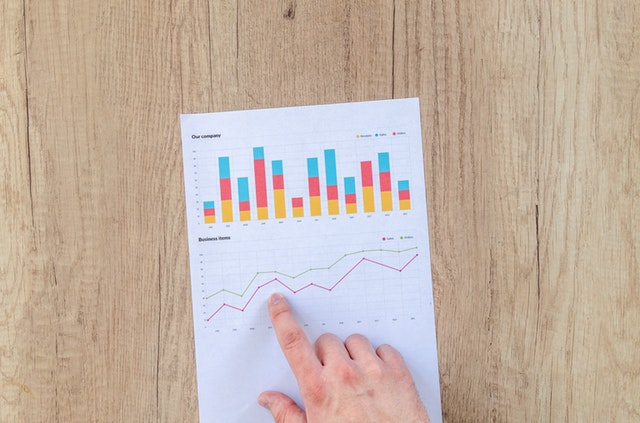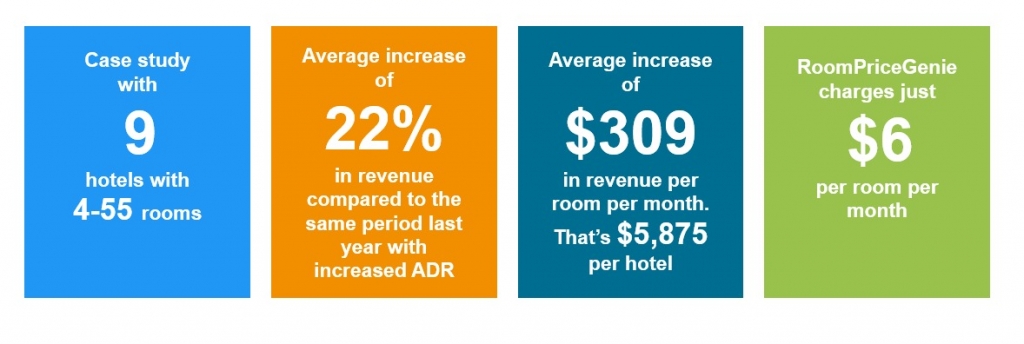
Summary
RoomPriceGenie makes dynamic pricing software for small and medium-sized hotels. Anecdotally there was a lot of positive feedback on the performance, but then again, customer quotes are often cherry-picked. This study is intended as a step towards quantifying the benefit of using revenue management software such as that provided by RoomPriceGenie’s unique type of algorithm. By using the performance of all hotels that we had access to on one provider of PMS and channel manager software, it was possible to follow 9 very different hotels for an average of 5 months. The results showed an average revenue increase of 22%, with median increase of 15%. This came with increased average daily rate (ADR) in eight out of nine cases.
Introduction:
“How much extra revenue will I make?”
It is the question that many potential customers ask before buying, but a difficult one to answer. It depends on what the hotel is currently doing, on the customer base, on how much leeway they allow for changes in price, on whether they use it on auto-pilot mode, and many other unknowns.
So, the real answer is “We don’t know”. But the rule of thumb that RoomPriceGenie used before, when asked, is:
a) If the hotel didn’t have a revenue manager before, using the software could reasonably expect to make 15% more revenue. Often hotels find this difficult to imagine; for a 20 room hotel this could be $60,000 per year. This is the reason that many hotels do not currently use any help with their pricing; they don’t realise the size of the benefits.
b) If the hotel did have a revenue manager, there can still be a significant improvement. By combining the expertise of the revenue manager with the consistent number-crunching of the software, the estimated increase in revenue was around 7%. The combination of the revenue manager themselves, the expertise of other revenue managers from competitor hotels, the many-times-a-day adjustment for pick-up and price changes in the competitor set lead to both time-saving and better results.
These rule-of-thumb numbers came from experiences with clients, but when it was possible to get the data, a systematic study is a far better approach than the previous anecdotal one. The particular software partner has standardised reporting which we could access, so this presented the perfect opportunity. Note that for the exclusively channel manager clients, we could only include bookings through the channels.
In fact, for this sample, the results were better than the rule-of thumb.
Key Metrics and Study Details:
The key metrics of the study are listed below, followed by the details of the study.
Key Metrics
- Over the 9 hotels there was an average increase in revenue of 22% and an average ADR increase of 4%. These were skewed by some outlying good performers, but taking median values give an average revenue increase of 15%.
- In terms of benefit to the buyer, the charge of $6 per room per month to use the software, was returned in revenue terms over 50 times over. The average increase per room was $309 per room per month.
- 8 of our 9 hotels experienced a greater revenue than last year. Incidentally, the one that was down on last year wrote to to say he was “extremely happy” because the system had helped him to cope with tough market conditions.
- Average Daily Rate (ADR) was higher in 8 out of 9 cases, with an average value of 4% higher.
- In the small sample of 2 hotels that had a revenue manager already, revenue increased on average by 10%
How does RoomPriceGenie increase both ADR and occupancy? The system aims to increase the price when the hotel would be getting full anyway, leading to a higher ADR. Then, at quieter times, it reduces the prices to increase market share. The increase in ADR from the former is larger than the decrease from the latter.
Details
Fortunately, the sample included a reasonably wide variety of different types of hotels. The sample has been broken down into the following categories.
- Hotel type
- Hotel size
- Geographical location
- Revenue Manager? yes/no
1. Hotel Type
In the sample of 9 hotels, 4 are countryside hotels, 3 are city hotels, 2 are seaside hotels and 1 is an airport hotel.
2. Hotel Size
Whilst the average room number in this study was 19, the smallest hotel involved had a total number of 4 rooms, whereas the largest came in at 55 rooms.
3. Geographical Location
Of the 9 hotels that participated in the case study, 5 are based in varying locations across the UK and 4 are located within continental Europe.
4. Revenue Manager
In this study, 2 of the 9 hotels already had revenue managers in place. Their businesses were already doing dynamic pricing, but saw this tool as a way to both save hours a day and also improve pricing. These hotels increased revenue by an average of 10%.
Investing in revenue management software does not have to act as a replacement of the revenue manager. RoomPriceGenie believes that software can act as the perfect accompaniment to a human. The idea is simple; a machine can gather more information and do more calculations than a human can. But humans with experience are better at understanding the overall context. The combination is the future!
Conclusion:
How much extra revenue will a hotel make? The answer is still “We don’t know”. But the study suggests that they type of software offered by RoomPriceGenie can significantly increase hotel revenue, either on its own or in combination with a revenue manager.



